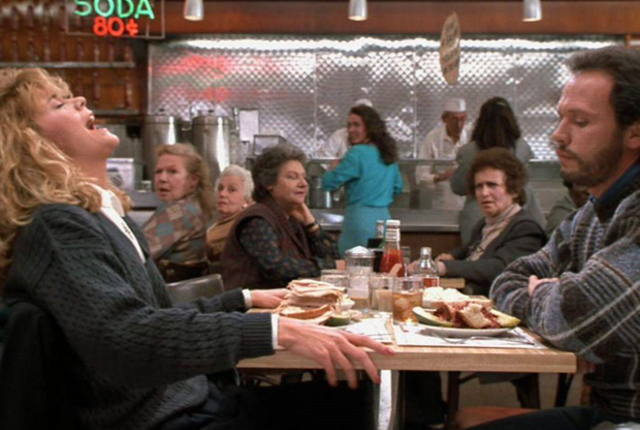Ever since Britain shipped Cary Grant across the Atlantic, the romcom has been a transatlantic English-language staple. This spirited and hilarious – whether intentionally or not – examination of the last 30 years of the genre, dominated as it is by WASPs (yes, white Anglo-Saxon protestants) and the Anglophone world, looked at why we are so fulfilled by these contemporary fairy-tales, and offered some surprising insights.
There were figures galore, of the financial kind: gross earnings, particularly. When Harry Met Sally (1989), $246 million, and we had the treat of the entire repertoire of orgasmic noises, with Mrs Reiner, mother of director Rob (you couldn’t make it up) gazing disbelievingly at Meg Ryan and uttering the immortal line, “I’ll have what she’s having” (that scene, pictured below). Those noises needed a lot of rehearsal, and were part of the underlying question of the film: can men and women be friends without a sexual subtext? The other salient point was that the audience is complicit: the audience knew that Harry and Sally were right for each other, the characters didn’t. Further stats came thick and fast. Pretty Woman (1990), $460 million, and the highest grossing romcom to date: it turned out that it was once intended to be much darker, a real examination of hookers of various ethnicities out on the street, and no happy ending.
Further stats came thick and fast. Pretty Woman (1990), $460 million, and the highest grossing romcom to date: it turned out that it was once intended to be much darker, a real examination of hookers of various ethnicities out on the street, and no happy ending.
Australia entered the fray with Muriel’s Wedding (1994), subverting the convention with an unconventional heroine: $58 million. PJ Hogan, a director more used to filming wildlife replete with jumping kangaroos, got to Hollywood with something even more subversive, My Best Friend’s Wedding (1997). The traditional framework, Julie Waters told us in an immaculate narration, is Meet-Lose- and finally Get, but not always. Here, famously, the girl did not even get the guy (and the girl, unbelievably, was the gorgeous Julia Roberts). She did get away with pretty villainous behaviour though, smiling and crying all the way: they had to tack on a spurious happy ending as she danced with her make-believe boyfriend, not-that-way-inclined Rupert Everett.
Simon Callow knew right away he would be the Funeral
More turn-ups for the books. My Big Fat Greek Wedding (2001), the exception that broke the WASP rule, described as a Valentine to immigrant America, took $368 million, 70 times its initial budget. In Sleepless in Seattle (1993), widower Tom Hanks and Meg Ryan didn’t even meet until the last minute of the film, described by its director as 90 minutes of foreplay: $228 million.
Notting Hill (1999) took a cool $360 million, nonsense but completely charming. Julia Roberts again, and the king of romcom, Hugh Grant, whose self-deprecating comments linked much of this visual essay. We were told by one of his directors, Marc Lawrence, that Hugh was whiny, neurotic and depressed, while Hugh, self-described as now an angry middle-aged man from Hammersmith, told us he did not like people much, although he quite liked one fellow player, a live bear. Richard Curtis, who had preceded it five years earlier with Four Weddings and a Funeral, did not even want to cast Hugh in that one, although Grant recognised Four Weddings as the first classy script he had seen in 15 years of acting. He had seen many that were not... We were told that he is still underrated (but grinning all the way to the bank).
Simon Callow knew right away he would be the Funeral. No one evidently had any idea that it would be a hit; Grant was convinced that its failure would be so embarrassing, he would have to emigrate to Peru. Its director Duncan Kenworthy had come back to London after supervising the Arabic version of Sesame Street, while writer Curtis had had a success with Blackadder. Also, unmentioned in the programme, that superb poem of grief by WH Auden that became known to millions.
We all knew comedy has its darker side, ditto love, but here it came wrapped up so nicely and with such wit that it was hard not to be charmed and come out a little happier. The genre, after all, is nothing if not elastic: 50% of marriages now end in divorce, so we even had a glimpse of I Give It a Year (2013) with the most subversive, insulting and inappropriate best man’s speech yet filmed.















Add comment